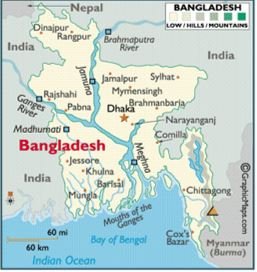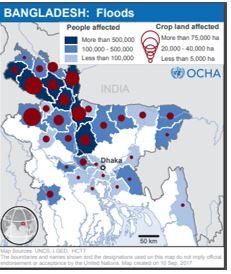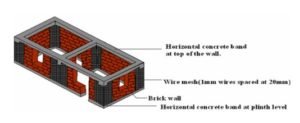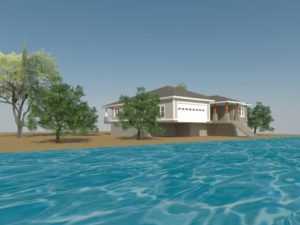Introduction
Bangladesh is known as one of the greatest disaster-prone countries internationally. Different reports have shown that approximately 10 million people are affected in Bangladesh every year due to at least one natural hazard. United Nations Development Programme (UNDP), in 2004 classified Bangladesh as the top-ranking country for the natural hazard of tropical cyclones while the country was ranked number six in terms of flooding as a natural hazard. Apart from these two hazards, Bangladesh is also prone to arsenic contamination, tsunamis, landslides, tornadoes, earthquakes, salinity intrusion, riverbank erosion, and drought. In 2017, the most disastrous flood enveloped South Asia and killed approximately 1400 people due to heavy monsoon rains in September. The most affected countries in the region due to the flooding were Bangladesh, Nepal, and India. Three districts of Bangladesh were severely affected which included Chittagong, Bandarban, and Rangamati districts (ReliefWeb, 2018)
This paper will focus on Chittagong and the construction measures that need to be taken for mitigating flooding in the future.
Context & Risks in the location
Chittagong, Bangladesh
Chittagong is the financial center as well as a major seaport of southeastern Bangladesh with a population exceeding 2.5 million people and is known as the second-most populous city in the country. This city is situated on riverbanks of the Karnaphuli River which is basically located between the Bay of Bengal and the Chittagong Hill Tracts. The study area selected for this particular paper is the Pahartoli Union of Chittagong which is under the jurisdiction of Raozan thana having a population of approximately 18,354 people (Tanjeela, 2015).
Topography
Chittagong spans the coastline of the Chittagong Hill Tracts which is located in the southeastern part of the country. And Karnaphuli River spans along the southern side of the city which also includes the commercial zone of the city. The Bay of Bengal is passed by the river passes through an inlet which is situated approximately 7.5 mi to the west of the city’s downtown. The highest mountain in the Chittagong District is Mount Sitakunda which is 351 meters high (Tanjeela, 2015).
Climate
Köppen climate classification has categorized the climate of Chittagong as tropical monsoon. The district is susceptible to tropical cyclones of the North Indian Ocean which makes the study area Pahartoli Union also vulnerable to these cyclones. Figure 1 shows a map of the country and location of the Chittagong district as well (Tanjeela, 2015).

Figure 1 Source: (ReliefWeb, 2018).
Situational analysis
Situational analysis of the study area shows that it is vulnerable to natural disasters due to its monsoon climate and its geographic location. Having a flat topography in addition to being a low-lying region result in flooding of 25% of the total land area of the country every year as two-thirds of the total land of Bangladesh lies approximately five meters above the level of the sea. This also results in 60% of flooding of the country every five years (ReliefWeb, 2018).
Having affected 8 million people in total in 32 different districts, destruction of 103,855 houses and 4,636 education institutes, recent flooding in September 2017 claimed 135 lives in southeastern Bangladesh which also includes Chittagong District and the study area for this paper, Pahartoli Union. Severe flooding was caused by rains which resulted in extreme flooding in most of the low-lying areas (Taohidul Islam and Chik, 2011). Communication and road infrastructure was severely damaged which resulted in delayed rescue missions and relief operations in the study area which resulted in the cut-off of the study area from the rest of the country and caused deficiency of food and clean water. Shelter from flood and rain, livelihood, and food supplies were the topmost concerns for the study area was submerged for at least 5 to 7 days causing severe damage to houses, crops, and road network. Damage to most of the houses as permanent as most of the houses was made of straw and mud. This has prompted people to live either in make-shift shelters or with extended family or under the open sky. Figure 2 shows areas affected due to 2017 flooding (ReliefWeb, 2018).

Figure 2 Source: (ReliefWeb, 2018).
Disaster Management Resources of Bangladesh
To decrease the vulnerability of the country towards natural hazards, the government of Bangladesh has invested more than $10 billion in different disaster management projects (Rheem et al., 2016). These projects comprise flood management systems; elevating roads and thoroughfares above the level of a flood; flood and cyclone shelters; early warning schemes for cyclones, floods, and storm outpourings; and the improvement of climate-resistant crop variations. The legal agendas for catering to disaster risk reduction in the country are the Standing Orders on Disaster and Allocation of Business for the Ministry of Food and Disaster Management. The Standing Orders on Disaster were implemented in 1997 by the Government for the provision of a comprehensive guide for emergency management undertakings and disaster risk reduction. These bodies are authorized by the government for different disaster management activities (Bangladesh’s Comprehensive Approach to Disaster Management, 2017). The roles of each body are summarized in the given Table 1.

Figure 3 Source: (Bangladesh’s Comprehensive Approach to Disaster Management, 2017)
Normal housing construction in Bangladesh
Mud walled House
Most houses in the study area are made of mud and straw. Some houses are made of sun-dried earthen blocks which are 12 to 24 inches thick. Thatch, clay tiles, or corrugated sheets of iron are mostly used for roofing of these houses (Porco et al., 2013).
Bamboo walled houses
Another common form of construction practices found in the study area is the use of bamboo for walls and corrugated sheets of iron for roofing (Porco et al., 2013).
Timber House
Apart from mud and bamboo, timber is also used for the construction of houses with a raised platform for protection against snakes, etc (Porco et al., 2013).
Timber and Brick built House
Brick is also used with timber in some parts of the study area the lower part of the house is made of bricks while the upper portion of the walls is made of bamboo reeds which are either covered with mud or cement. Corrugated sheets of iron are used for roofing and timber logs are used for making posts (Porco et al., 2013).
Corrugated iron Sheet Houses
Corrugated sheets of iron are also being used for the construction of houses due to their durability and protection against rain. But the use of this construction material depends on the financial conditions of the people as most of the people belong to a low-income class, they cannot afford this (Porco et al., 2013).
Thatch walled House
Some parts of the study area have houses made of thatch, jute sticks, long grass, and straw as these materials are quite economical and easily available. Apart from jute sticks, the same building material is used for roofing. Another reason for using this material is that it is easy to dismantle this material in case of a flood (Porco et al., 2013).
Masonry House
Although masonry houses can be seen in parts of the study area their number is quite small. Brick flat soiling is used for foundation but due to the creation of shear and tensile stress in the walls, these houses get damaged easily due to rain and flooding (Porco et al., 2013).
Socio-cultural-political-economic context relevant to the reconstruction
As mentioned before the people of the study area are quite poor and live in a rural area. Most people use construction material that is locally available and cheaper in price. Since the material used is of low quality and local techniques are used for construction, the houses are prone to damage and do not have the resilience required against natural hazards like floods and earthquakes (Rheem et al., 2016). Construction of houses in the study area has developed a pattern according to the requirements of the residents as per their cultural and socio-economic development. Low-income people have constructed their houses of cheap indigenous material like straw, jute sticks, bamboo, mud, thatch, etc. but some of the houses are also made of corrugated iron sheets and bricks due to the influence of the urban development in some parts and is also subject to financial abilities of the people constructing those houses. Enclosures are mostly made of jute sticks, bamboo, straw, and iron sheets which are combined with mud for finishing. Corrugated iron sheets in combination with thatch are commonly used for roofing systems (Izumi and Shaw, 2014).
The use of local techniques for construction can be attributed to the lack of skills required for the construction of hazard-resilient houses. While hypothetically, if suitable assets and building material for construction are being made available, there is a chance the people will be able to construct buildings that will resist flooding in the future. The people of the study area need to be educated about different construction techniques that can be used for the construction of weather-resistant houses. This can be done by identifying the structural deficiencies that exist in existing practices of construction regarding the frequency and severity of flooding. Strengthening techniques need to be formulated for existing houses so that they can become resilient in terms of natural hazards like floods and cyclones. The constructional methodology also needs to be formulated for flood-resistant houses in the study area by using indigenous construction material (Izumi and Shaw, 2014).
Reconstruction Design Suggestions
As mentioned before, the majority of the residents of the study area build their houses by using local materials such as bamboo, mud, thatch, straw, jute sticks, and sun-dried bricks. Studies have shown that out of the total population of the study area, 12.71% reside in non-engineered R.C.C. dwellings, 18.83% reside in masonry dwellings, 36.63% reside in bamboo dwellings while 31.83% are living in houses made of mud. There is little to no ventilation in most of the houses as these houses are built by the owners. As the majority of the people in the study area belong to a lower middle class, they mostly have jobs like teachers and shopkeepers (Izumi and Shaw, 2014).
Masonry House
In general, houses or buildings constructed by using solid concrete blocks fired brick, and mortar blocks are categorized as masonry buildings. No reinforcing material is used in the construction of this type of dwelling or building for resistance of tensile and shear stress which is created due to lateral loads like earthquakes and cyclones. Since these types of houses are not very common in rural areas, their demands seem to be increasing due to their durable quality as compared to other houses made of indigenous material like mud and bamboo. However, mud houses can be improved in terms of strength against floods by inserting L-clamps, inclined and vertical members into trusses, and rectangular metal straps in places where connecting members of roof beams and truss are located. The use of cross bracings in purling can also help in improving the strength of the houses (Porco et al., 2013).
For minimizing the damage as a result of differential settlement in the foundation, the use of reinforced concrete strips is most effective which can be attached to the already existing foundation of the house. For reinforcement, bamboo can be used which is easily available and cost-effective and will be easily affordable for the local people. One or two-story houses can be easily reinforced with the help of bamboo which will make the house resilient in case of flood and cyclones (Porco et al., 2013). The reinforcement method of prevailing masonry dwelling is demonstrated in the Figure below.

Figure 4
Non-Engineered R.C.C. Building
In recent times, the RCC dwellings have also become quite popular in some of the rural and areas due to their qualities like improved strength and enhanced durability. But since the buildings are constructed by local builders, the lateral loads are not considered in addition to negligible connection details which make the building vulnerable to collapse due to rain and flooding Huang, 2017). These non-engineered RCC dwellings can be improved by jacketing the existing columns and beams. This can be done by caging reinforcement through the addition of several concrete rings. It is common knowledge that reinforced cement concrete is the most acceptable construction material used by engineers all over the world and its durability has made it one of the most popular building materials. Implementation of a suitable design and cautious construction process will be more than enough for making the dwellings flood resistant. The reinforcement method of prevailing non-engineered RCC dwelling construction is demonstrated in the given figure (Porco et al., 2013).

Figure 5
Reconstructed house layout
A restructured house layout is given below for a single-story housing unit with three bedrooms and two entrances, one from the front and one from the back. The house is elevated 10 feet above the ground and can be escaped from the back in case the flood water comes from the front. The strengthening method for this type of house is formulated by using the locally available material for construction while the techniques used for construction are based on engineering science so that the houses can become flood resistant (Porco et al., 2013).

Figure 6

Figure 7: A reconstructed design for flood-prone areas.
References
Bangladesh’s Comprehensive Approach to Disaster Management. (2017). World Resources Report Case Study. [online] Available at: http://www.worldresourcesreport.org/ [Accessed 28 Feb. 2018].
Huang, M. (2017). Vulnerabilities to housing bubbles: Evidence from linkages between housing prices and income fundamentals. International Finance, 20(1), pp.64-91.
Izumi, T. and Shaw, R. (2014). A New Approach of Disaster Management in Bangladesh: Private Sector Involvement. Risk, Hazards & Crisis in Public Policy, 5(4), pp.425-445.
Porco, F., Porco, G., Uva, G. and Sangirardi, M. (2013). Experimental characterization of “non-engineered” masonry systems in a highly seismic prone area. Construction and Building Materials, 48, pp.406-416.
ReliefWeb. (2018). Bangladesh: Floods and Landslides – Jun 2017. [online] Available at: https://reliefweb.int/disaster/ls-2017-000068-bgd [Accessed 28 Feb. 2018].
ReliefWeb. (2018). Humanitarian Funding Update September 2017- United Nations Coordinated Appeals. [online] Available at: https://reliefweb.int/report/world/humanitarian-funding-update-september- 2017-united-nations-coordinated-appeals [Accessed 28 Feb. 2018].
Rheem, S., Choi, W., Kwak, C. and Oh, K. (2016). A Cooperative Emergency Response System based on the Disaster Response Activity Plan. Crisis and Emergency Management, 12(4), pp.1-15.
Tanjeela, M. (2015). Women and Climate Change Adaptation in Bangladesh. The International Journal of Climate Change: Impacts and Responses, 7(4), pp.61-74.
Taohidul Islam, S. and Chik, Z. (2011). Disaster in Bangladesh and management with the advanced information system. Disaster Prevention and Management: An International Journal, 20(5), pp.521- 530.


